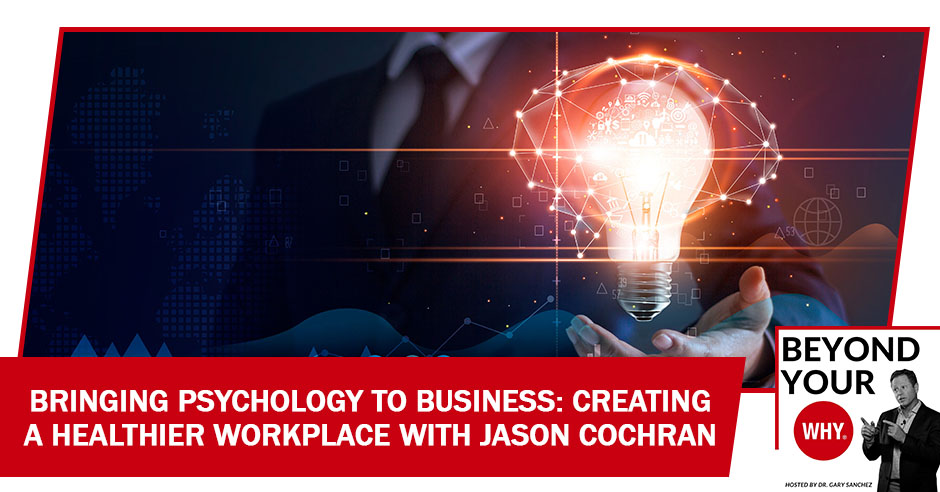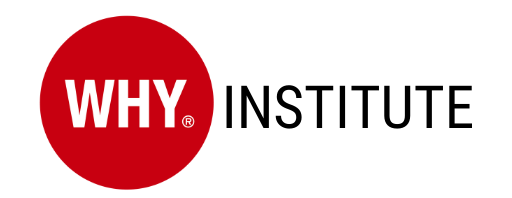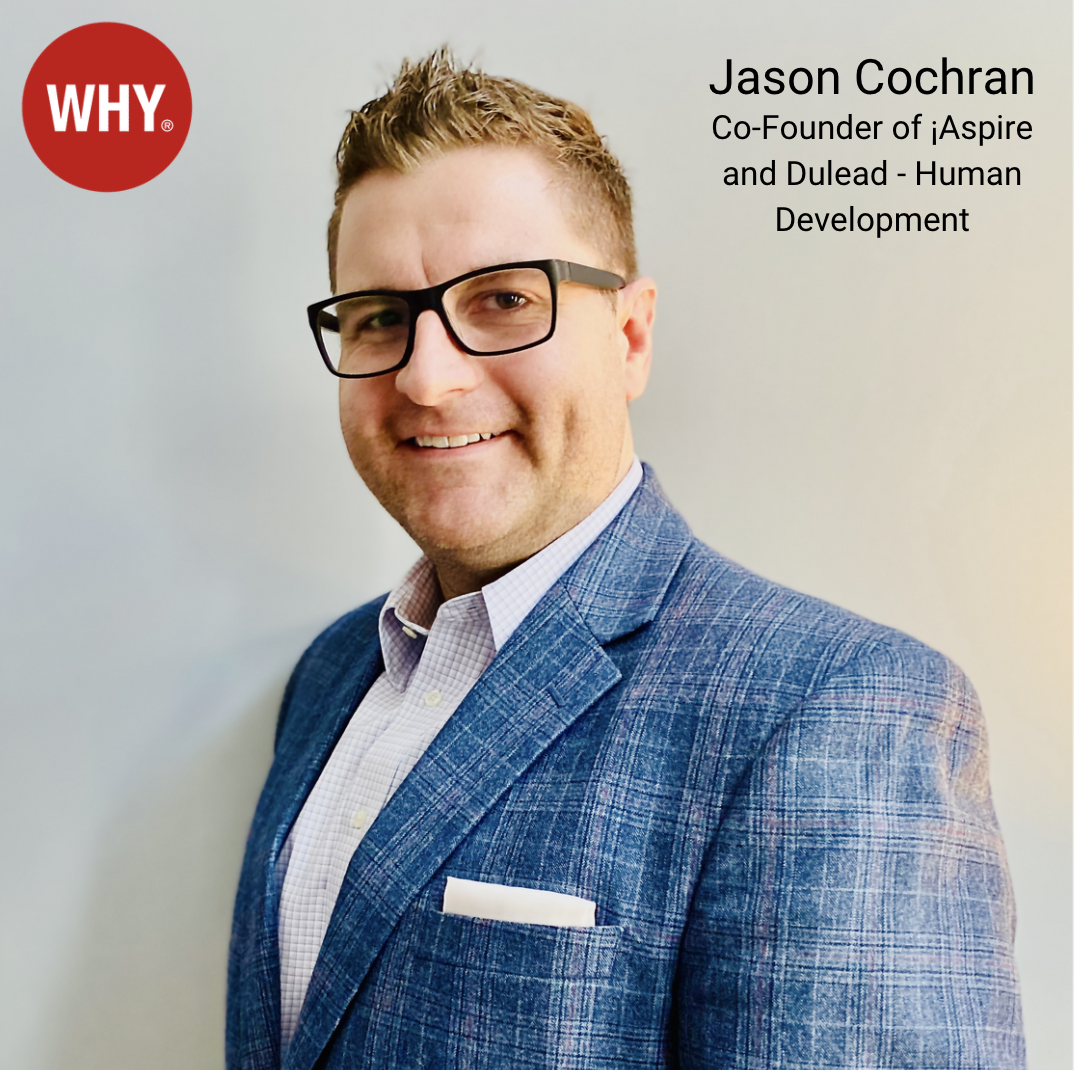
Do you relish in making the world better, even from behind the scenes? Do you count group victories as personal victories? Do you enjoy being a part of a greater cause, something bigger than yourself? If you answered yes, you have the WHY of Contribute! Just like our guest for this episode. Dr. Gary Sanchez sits down with Jason Cochran, an organizational psychologist and the co-founder of technology companies iAspire and Dulead, both of which are focused on human development. His passion is to help organizations build growth cultures where people elevate to their potential and organizations fulfill their missions in the world. Jason believes he has a lot to contribute, and not selling himself short is an important part of making those contributions. In this conversation, he takes us through the ways he contributes to the world by taking the path of psychology and bringing that into the business world. He talks about creating a healthier work environment through his 4 Principles of Connection framework, which helps people find meaningful work and fulfillment. Join Jason as he tells us more!
—
Watch the episode here
Listen to the podcast here
Bringing Psychology To Business: Creating A Healthier Workplace With Jason Cochran
Welcome to the show where we go beyond talking about your WHY and helping you discover and live your WHY. If you are a regular reader, you know that every week, we talk about 1 of the 9 WHY’s, and then we bring on somebody with that WHY so we can see how their WHY has played out in their life. In this episode, we are going to talk about the WHY of Contribute to contribute to a greater cause, add value, or have an impact on the lives of others.
If this is your WHY, then you want to be part of a greater cause that is something bigger than yourself. You don’t necessarily want to be the face of the cause, but you want to contribute to it in a meaningful way. You love to support others and you relish successes that contribute to the greater good of the team.
You see group victories as personal victories. You are often behind the scenes looking for ways to make the world better. You make a reliable and committed teammate, and you often act as the glue that holds everyone else together. You use your time, money, energy, resources, and connections to add value to other people and organizations. I have got a great guest for you. His name is Jason Cochran. He is a business psychologist and the Cofounder of technology companies, iAspire and Dulead, in Indianapolis, both of which are focused on human development.
Fascinated with the exploration of human potential, Jason has devoted his life to building scalable solutions that attract, develop, and retain talent. He also has hands-on experience working with organizations in education and business leading people, change, process, process improvement, and digital transformation in consulting roles.
Frustrated with the shortcomings of failed employee engagement initiatives, Jason created the Four Principles of Connection framework, which is connecting with self, others, role, and the organization, which creates purpose through meaningful employee experiences and addressing the innate needs for why people desire meaningful work in their lives that leads to fulfillment.
His passion is to help organizations build growth cultures where people elevate to their potential and organizations fulfill their missions in the world. He joined Top 10 Global HR Thought Leader, Ira Wolfe, as cohost on the Geeks, Geezers and Googlization show where they interview global thought leaders concerning the convergence of people, technology, and the future of work, jobs, careers, business, and HR. The show is rated as a Top 50 Business Podcast by Thinkers360 and is ranked in the top 10% globally out of nearly 3 million podcasts.
—
Jason, welcome to the show.
What an intro, Gary. Thank you so much. I am excited to be with you and your audience.
That was a mouthful. There is a lot to unpack there.
We are going to unpack it really well in this episode because we are going to talk about the WHY, which is at the center of most of what I do, or at least I try to do.
Let’s go back to where you grew up. Tell us a little bit about your childhood.
I grew up in Logansport, Indiana. It is about an hour and a half North of Indianapolis, Rural, Indiana. I had 50 people in my graduating class, and that was not a private school. That was a public school. We were one of the smallest schools in the state. Once I graduated, I went down to Nashville, Tennessee, for college. I became a psychologist. I would have stayed down there. I loved Tennessee, but pretty much all of my family was back in Indiana. I missed them, so I ended up moving back to Indiana and have been doing work in psychology in a lot of different areas since then.
What were you like in high school? Take us into your high school. Were you the guy that was on the sports teams, a guy that everybody came to to help them solve their problems, or the outcast?
I was shy. I was an introvert. What a lot of my classmates would be surprised at now is that I am doing keynote speeches and that I put myself out there to try and help other people because I mostly kept to myself. My wife was the head of the cheerleading squad in the bigger school on the other side of the county. She jokes that the only time I would make it onto the sports field was at halftime when I was playing the trumpet.
I was not a jock either, but the thing that I did well and that most of my classmates would probably say about me was I was a pretty adaptable guy. I hung out with the people who were in the skater clique, the nerd clique, and the band clique. I also hung out with the jocks. Part of that is maybe part of my personality, but part of it too was it was such a small school that most of those cliques had similar people and were in multiple parts of those groups. Those are some of the characteristics that most people would think about me.
[bctt tweet=”If you open yourself up to entrepreneurship to start something that you believe in, it will change you for the better.” username=”whyinstitute”]
I certainly think about myself as adaptable, but I was also very quiet. The other thing too that is very different about me now compared to who I was then was back then, I was not competitive. My parents would say, “Don’t you want to be valedictorian?” I was like, “No. I am fine with being in the A-B range and being in the 8th to 10th best in terms of academic metrics in the class.”
Now, if I am not number one, I am pushing for number one. That is how I am. I have got that competitive edge, and it is not to beat other people. It is to be the best that I can be because I owe it to myself, to the people that I love and to the world to give the best that I can to try and contribute in the ways that make it a better place.
When did you have that shift? When did you suddenly go from the non-competitive to the guy that is like, “I got to do this at a high level I can’t just blend in anymore.”
2012. It is funny to throw out a specific year number, but the reason I know that is because that is when I went from practicing as a psychologist primarily in educational schools to taking a step forward to becoming an entrepreneur and helping to start some technology companies. At that time, it was the start of the company, iAspire, that I tried to help get up off the ground with my friend, Eric Bransteter, and fellow cofounder.
I liken entrepreneurship to parenthood in many ways. You love it, but the rollercoaster of the ups and downs, the number of times you stub your toes and you think you are losing your mind is crazy. Ultimately, what it does, regardless of whether or not your venture is successful or fails, if you open yourself up to entrepreneurship to start something that you believe in, the end result will change you for the better. I guarantee it if you are open to thinking about it that way.
For me, 2012 was when I took that leap to start iAspire. That was when I started to notice the shift in my mindset of not settling in life. Understanding that there is a lot that I have to contribute, not selling myself short, and making sure that I was doing the things I need to do to make those contributions because if I don’t, who else will? There is only one of me in the world with the unique skills, gifts, and talents that I have in the way that God made me. It is my responsibility to understand those and then to use them to make the world a better place for other people.
You went off to college. How did you pick the path of psychology?
It happened in fourth grade through some personal tragedies in my family, unfortunately. In fourth grade, my grandfather took his life. He committed suicide. At that time, I didn’t know what depression was, but he was going through it. That was my first time hearing the word suicide and even understanding or hearing that people would take their own life. I wrestled with that as a kid. About a year later, my aunt, who was his daughter, also took her life. Early on, I saw those tragedies happen. I started asking my parents a lot of questions about why I didn’t know this type of thing would happen and why is it happening to people I love in our family.
By the time I got to high school, I was like, “I want to take classes in psychology. I want to understand behavior, thinking, mindsets, and emotions.” I didn’t know what I wanted to do with it, but I was curious about it and I wanted to learn more, so then when I went to college, I knew I wanted to be a psychologist. It was going to be the way that I was going to try and make a great contribution to the world to try and help other people.

After that, what ended up happening was a pretty circuitous path. I started in educational psychology working in schools to create healthy school cultures. Now, what I do is I work with businesses applying the same types of principles and systems that we put in place and processes, but it is on the business side of things to make sure that the employee experience is the driver that you are focusing on until you have the type of culture you need to have as an organization. That is a little bit behind why psychology gave me an initial interest as a field of study and then why I am doing what I am doing now.
It is to have a bigger impact. I know you took the WHY.os Discovery, which told us that your WHY is to contribute to a greater cause. How you do that is by making sense of complex and challenging things, and ultimately, what you bring is a trusting relationship where others can count on you. You can sure see that play out in the path that you took. You wanted to have a bigger impact. You jumped into something very challenging, which is mental health, and figured that out as much as you could. You then became the trusted source for others to rely on as you went through school. Now, you are taking that into the business world.
For me, there are two other people that are a big part of the story as to why I am doing what I do, and that is my sister, Kim, and my father, Richard. My dad had a job that he didn’t like, but he did it because it put food on the table. It was strictly a transactional thing. I saw him do that for a long time. Unfortunately, with the chronic stress of that type of work, when you eventually get to the end of the rainbow, you think, “If I can get through retirement, it is okay. I don’t need to enjoy what I do. It just needs to provide for things.” If you do that long enough and work for a toxic boss or a toxic work culture, it can put a strain on your health or your mental health.
Unfortunately, by the time my dad got to retirement age, there were a couple of years there where his quality of life was good in terms of being able to do the things he used to be able to do, but then quickly, a lot of the health challenges started coming up. Part of that is related to the amount of stress that he went through for quite some time. My sister was an HR professional and she worked for a company that was very challenging in terms of ownership. She got to a point where she was like, “This isn’t suiting me anymore. I am going to go ahead and retire early,” so that she can go ahead and start taking care of her grandkids.
I looked back at the experiences they had with work. I know that part of my contribution, to put it in simple terms, is I want to help make work not suck so bad for so many people or that so many work environments are toxic that isn’t helpful. That is what I am on a mission to try and do through the various ventures that I am a part of, and also, toward the future too.
I have four sons. The oldest is eight, the next one is four, and then the youngest two are twins. They turned two this 2022. I am thinking about the future too. I am thinking I want this to be a world where work does make up a healthy part of your identity. It does matter beyond just being something transactional but you are doing work that makes you feel fulfilled, brings meaning to your life, and helps you grow as a person. It is also healthy for your other relationships and forms a healthy aspect of your identity too.
Why should we say it shouldn’t be that way when it is one of the biggest parts of our life?
I agree. We have made excuses for too long when it comes to working environments. I can’t tell you the number of times I have heard people say, “It is just to pay bills. Work should be work and home should be home.” We have made these excuses for work to say, “I just need to get through it. It is okay for it to suck.” I don’t think so. When we make our best contributions in the world, it is when the organizational environment isn’t sapping your soul when there are basic pieces in place that make you feel appreciated and make you feel recognized. That is what led me to create the Four Principles of Connection.
I was frustrated with what I saw organizations were trying to do because employee engagement levels haven’t moved for many years. A big part of that is because organizations were looking at it as, “What can we do for our people in order to squeeze more out of them?” Instead, that needs to be flipped on its head and be, “What do we need to provide for our people?”
[bctt tweet=”We make our best contributions in the world when the organizational environment isn’t sapping your soul.” username=”whyinstitute”]
Think Maslow’s Hierarchy of Needs that makes them feel safe and secure, gives them the resources that they need so that they can do some incredible work, and deliver value for internal and external stakeholders. I like to solve complex problems. To me, we have overcomplicated a lot of people’s strategies.
The Four Principles of Connection is all about creating experiences for employees where it helps them better connect with themselves, with others, and with a role that fits their strengths, and then help them connect to the mothership or the organization, at a high level, then you are not only providing value to your employees. You are also providing value to your external stakeholders as well because you are not churning and burning your talent.
What did you learn in working with students and schools that allowed you to make the jump into business? They seem like different animals, but maybe they are not.
Here’s the thing that I saw that was similar. There ended up being a lot of decisions that are made at the top that are then pushed down below. What I mean by that is in schools, oftentimes, teachers would say, “I can’t understand why Billy isn’t doing this in the classroom.” Have you ever asked Billy? Have you ever asked him for his input as to why he is doing X behavior and what it is doing for him and why he is not doing what you want to do?
Typically, what would happen in schools if I were the teacher is, I would be like, “Billy’s got a problem because he is getting under my skin.” What I am going to do is I am going to meet with the principal, some other teachers, a psychologist, and his parents. I am going to meet with everybody but Billy and we are going to come up with a plan as the adults as to what we want Billy to do, and then we are going to make him do it with carrots and sticks.
A famous psychologist by the name of Ross Greene came along in the ‘90s and said, “If you want to solve most of your behavior challenges in schools, you need to use collaborative problem-solving. The most important person at the table is the person who is struggling with the behavior.” Everybody wants to do well. Nobody wants to do poorly. If you don’t have Billy at the table being an active stakeholder in that participation in his own behavior, you are going to fail.
The leap to business is for too long, we have been doing things to employees instead of with them. We are at a remarkable point in history because of the labor market and the challenges of finding the right talent. The leadership in many organizations that have had a modus operandi of, “We are fine with turnover,” are starting to rethink things and think, “In this concept of employee experience, employees are our first customers.”
Every day, they are asking whether or not they are bought into the organization, culture, brand, solutions, and offerings that are going out to the marketplace. You can’t help your customers if you aren’t helping your internal customers first, which are your employees. For me, that was where I saw the parallel. There was way too much, especially at the top of leadership, coming up with things behind closed doors among leadership and saying, “This is what we think and the direction we are going to head with not enough buy-in and input from the frontline folks who, many times, are the ones closest to the real problems that the organization is trying to solve.”
Why does this seem so obvious and so much common sense? How the heck did we get so far off track?

It is a lot easier to hop in and solve things yourself. I don’t know about you. I’d love to hear your perspective on this. I can tell you, as a husband, many times, my wife reminds me my job needs to be to listen and not necessarily to always jump to conclusions, think I know the solution and give her the solution to the problem. The tendency for us most humans to jump to solutions is because that is a lot easier than it is to sit, be empathetic, understand things, take a while to think through them at a metacognitive level, and sort through them than it is to take the time to run focus groups and do interviews to understand the problem.
It is a lot easier to behind closed doors or in a vacuum and come up with solutions that you think to what the real problem is. That is why businesses often get themselves in trouble. It is because it is much easier to come up with solutions than it is to take time in the problem analysis step of problem-solving to dig in, listen to your people, figure out what’s going on, and put the puzzle pieces together to solve the problem.
If you get a call from a company that is struggling with culture problems, losing employees, not being able to hire, and not being able to move forward like they want to, what do you do with them? Take us through your process.
One of the first things I want to look at is the values of the organization. Something that I have learned from a lot of Dave Orrick’s teachings is when it comes to values, many times, those are formed from the inside out. In other words, they are like, “This is who we want to be,” but they also need to have this aspect of values, and who they are as a company needs to come from the outside-in. That means they need to interview the customers whom they are trying to impact and serve, and the value they are trying to deliver for them.
If you are only coming up with values internally, then you are missing a big piece of what drives your business forward, which is ultimately delivering value for your customers and those stakeholders. For me, I always want to take a look at the values first. If they are written in flowery language but it is not clear to me how I, as an employee, would need to do behaviorally in terms of my behaviors to live out integrity at Acme Corporation, that is where we need to start first.
There needs to be an understood codification of values and behavioral terms written so that people know what success looks like. I have found that is pretty much the first step with any organization I have partnered with in getting some clarity around. The values are the behavior that people understand as opposed to the flowery language that is on a poster.
There are two things there. Firstly, Can you define values for us? Secondly, give us an example of what you are talking about.
Values are sets of principles that are important for people to live out. For example, I listed one of integrity. A behavioral indicator that I like to say of integrity is one, do you follow through on what you said you are going to do? If you made a promise to another employee, to your boss, or a customer, did you follow through on delivering what you said you were going to deliver? At this concept of integrity, we are going to move it down a level to a description and say, “Integrity for us at Acme Corporation means you need to follow through on what you have promised to a customer, another employee, another staff member, or your boss here at the organization.”
At the end of the day, people can only remember so many things. What I have found is the more that you drill down and don’t have any more than about 3 or 4 values in your organization, most people are going to be able to remember those, especially if they have spaced repetition. Those things are being practiced and rehearsed, and also reinforced and celebrated.
[bctt tweet=”Employees are our first customers.” username=”whyinstitute”]
People need to be nominated and recognized whenever they are living out those values. When those things are modeled and you consistently reinforce those, that is when people go from having an intellectual understanding of what integrity means at Acme Corp to, “I know this is the thing that I need to do when I am in this situation and there is tension. I know what I need to do behaviorally because I know that integrity means I need to follow through on what I promised I would do for that other person.”
What I am hearing you say is companies need to have their values the way have them, but then have them defined in behavioral terms so that people know what it means. You said integrity. I get it. Everybody’s got integrity written down somewhere, but what do you mean by that here at Acme?
That is exactly right. One of the things I have learned from some communication experts is as many of us would like to think we are really good at communication, we aren’t very good at it at least in terms of communicating with the other person leaving and feeling like they have clarity around what they are supposed to do. Internally, we may feel like, “I did a good job of telling that person what’s expected and what needs to be done,” but what you did there is a perfect example. You did a reflective listening and questioning technique. You said, “If I am hearing you correctly.”
Those simple little steps to clear up the communication is so important, and that is where codifying the values and moving it from the flowery language to, “Here are three examples behaviorally of what it means to live out integrity.” Those are the things that people will eventually know, understand, and be reinforced for. That is how you are going to get your values lived out in the organization in a way that matters, and ultimately, that makes sense to them.
Do you find that most companies articulate the same values? Are there the same three values that keep showing up over and over with all the different companies you work with or are they all over the board?
There is a top three, and those top three would be Trust, Integrity, and Service. At least in the work that I do, those are the three that come up the most often. What’s interesting is that can be expressed in some different shades. There is one degree of separation from another for each company. In terms of what that is mostly landing on, it is landing on the same types of concepts that the company believes are important. Not only internally, but to make sure that they are delivering the appropriate value to their external stakeholders.
Now you have gone in. You have looked at the company values. You have seen that maybe they weren’t, but they are written out in behavioral terms so that it is clearer exactly how we behave based on these shared values. What happens then?
We got to reinforce them and we have got to do it in what I call Spaced Repetition. What I mean by that is this can’t be something that we do once a month. It has got to be something that is done on the regular or maybe once every couple of weeks. The reinforcement piece is if you have any type of award or recognition program, I highly recommend that you either align it to living out the values in your organization or you come up with a separate one specific for living out the values because it is important.
What you are going to do is you are going to have this recognition program that says, “This week, we want to nominate and recognize people that we have seen do something that relates to living out integrity. As a reminder, here are the three behavioral characteristics of what integrity means at Acme Corporation. Let’s nominate and celebrate people that you have seen do that.”

You need to consistently do that and make sure that you are reinforcing to people that they are being caught in the moment and celebrated and appreciated in ways that matter to them. It is not the way we want to recognize and appreciate them, but ways that they want to be shown appreciation and recognition for living out those values. That is critically important.
This is something that has got to be consistently done over time. Whenever you bring somebody new on staff, you need to make sure that they are being reinforced at a certain cadence as well for living out those values. That is how you get people pulling in the same direction. That is how from an organizational behavior perspective, you get people focusing on the right behaviors, and ultimately, how you develop habits over time.
This isn’t something where you say, “As part of orientation, you are going to hear about our values. We have these posters that are on a wall.” The way that you do it from a behavioral perspective is you got to practice, model it, and reinforce it, and you need to be doing that on the regular throughout the year with your people.
Eventually, what’s going to happen is those things are going to become more automatic processes for people. They are going to know it like the back of their hand, and that is what you eventually want so that whenever certain situations come up and they are wondering, “What should I do?” More times than not, they are going to have the answer in their heart and in their head of how they should handle a difficult situation because they know what it means to live out integrity at Acme Corporation.
As we look at your WHY, how, and what of how do we have a bigger impact and how do we solve the challenging problems we are facing, the third critical piece to that is how do we preserve and enhance relationships? How do we create trusting relationships? How do we trust each other? What part of a company or a successful organization do you think do relationships play, especially trust in the relationship?
It starts with leaders being open, honest, real, and authentic. Here’s what I mean by that. We are going to get into the mental health aspect if that is okay. This is important. For too long, many people have felt like they can’t acknowledge the mental health challenges that they have. In fact, most of the time when we even mention mental health, people think of it in a negative light. It is no different than physical health. We are all on the spectrum somewhere of mental health, whether it is more toward the positive end and having a really healthy lifestyle when it comes to our mental health or toward the other end of struggling and maybe even possibly having some mental illness.
We have a problem with stigma in this country regarding mental health. I share with leaders, “One of the quickest ways that you can build trust with your people is to acknowledge challenges you have, whether it is with mental health, in your job, or in relationships that you have. People do not want to work for a robot or with a robot. They want to work with someone that they think comes to work and has flaws, faults, and hang-ups like they do in life too.”
If you are a leader and you think that your people think you are perfect, I got news for you. They know you are not perfect. They might be able to point out your faults better than you know them yourself. I always encourage leaders, “Make sure you are getting feedback on how you can be doing better, not just in terms of business operations, but as a human being. How can you do a better job of creating those connections?”
When we talk about trust, the first thing that people are looking for when they are thinking to themselves, “Do I want to follow this person? Do I value their opinions? Do I feel connected to them? Do I feel like I can be who I am around them and be vulnerable?” The only way they are going to do that within a business relationship is if the leader takes that step first. I often encourage leaders, “You don’t have to share everything, but you need to be able to share and open up on those challenges.”
[bctt tweet=”One of the quickest ways you can build trust with your people is to acknowledge the challenges you have.” username=”whyinstitute”]
The reason that leaders struggle with this, in particular, is because they are used to having the answers. They are high achievers. Typically, they wouldn’t be the leader in an organization without being very successful. There is this concept of, “Don’t show your faults. Don’t talk about those.” It is very important when you are trying to build a culture of trust with your people where they are going to feel like they are respected, heard, and seen for who they are.
It is important that leaders model that first and acknowledge their faults, admit the times that they were wrong, or talk about the things that they are challenged by. Don’t just share that with your inner circle. You need to share that with everyone to build a connection with everyone because that is what they want to do. They want to connect with you at a high level.
When we talk about building trust in an organization, it is important to define what trust is. What’s as equally important is those behaviors we say that show how we are being successful at living out trust, leaders have got to live that out. One of those things is by being open, honest, and moving beyond certain stigmas that leaders often have of thinking, “I can’t share my faults and the things that I am struggling with.” You can. Your people want you and expect you to do that, and that is how you build trust.
I have heard this a lot. I have heard leaders of organizations say things like, “I have tried all this connecting and being vulnerable stuff. All that has gotten me is a lot of extra stuff I got to deal with it but all I want is someone to get the job done.” It has added a lot of drama and trauma to the work that they have to deal with in order to get the same process done. I have heard this over and over by people who have tried the EQ and all this other stuff and said, “That all sounds great on paper, but I want this moved from here to here. I don’t want to know all that other stuff. I want something done.”
I want to add to that or hear your perspective on how you think that will affect the rapid automation or movement toward robots and having a workforce that is a robot versus a human. I know that is way out there, but it is coming fast. I heard this speaker when I was in Florida that is an AI expert. He owns a robotics company. He was saying that it is coming faster because employers are tired of having to deal with all the extra stuff. I would love your perspective on that.
The first thing we should consider is there is probably a little bit of context. Certainly, there are going to be jobs that are replaced by automation, and they should be replaced by automation. For example, a fry cook-type thin. I have seen restaurants in California that already have automation and robots that are rotating fries and doing stuff like that, but we need human beings working on delivering value as in solving complex problems. We are using our higher-order critical skills and not doing mundane, repetitive work. Those things should be automated.
When you think of the executives you referenced and certainly the ones I have heard from when they are talking about frontline employees and maybe dealing with some of this stuff of getting into the vulnerability, I certainly understand if you are running a fast-food restaurant that maybe some of those things aren’t necessary because the job itself by definition is very rote and mundane. You know that it is going to be high churn. It is probably not a destination employer-type job where someone sees themselves staying there doing that type of job for a long time.
When we talk about other types of work where we are solving complex problems, that is where you better make sure as a leader that you are developing those core relationships, because otherwise, you are going to struggle to get the top quality Millennial and Gen Z talent moving forward. There is a high expectation from those specific talent pools to work for companies that care about them as a person, and that is not going to change. They will go find another gig or start their own business. They have come up with very creative alternatives for what to do outside of working for your company if you are not showing that you value them.
I agree with you that when it comes to the rote, mundane type of work that is very repetitive and simplistic, that is going to be replaced by automation. You probably don’t need to spend a tremendous amount of time banging your head against the wall investing in vulnerability programs. However, for organizations that are trying to deliver stakeholder value or solve very complex problems in the world, you are going after the top talent in order to solve those things.

One of the drivers, whether they like it or not, is people want to be valued and respected by their employer, and that means all of who they are. One of the people on our podcast is a Gen Z futurist. Her name is Danielle Farage. She shared something with me that blew me away. She said that bad leaders and bad companies can no longer hide from the talent pool when it comes to Millennials and Gen Z. She said, “We have eyes and ears everywhere.”
Before they even go in for an interview or consider putting in an application to work for your company, behind the scenes, they are going through all of their networks. They have very extensive networks because of the social media platforms they can get from Glassdoor and all of these other sources of information about the company. They are doing their homework before they come in to understand who the leadership is and what the company is beyond what’s posted on the website. They are doing the nitty-gritty of reaching out sometimes to some of the employees that work inside the organization and asking, “What’s it really like to work there?”
This is the way that the talent market is going to be. You must follow through on the employer brand. If you think some of this stuff is fluffy and kumbaya, I get it, but I don’t think you are going to have any fingers of blame to point at anybody else if you are struggling to get the talent when it comes to Millennials and Gen Zs. It is because these are the type of workplaces they demand now. This is why we are seeing a rise in certified B Corp or ESG. Quite many of the companies that are focusing on those kinds of concepts are outperforming other companies that are focused on traditional capitalism concepts in the S&P 500.
We have the data to show that this is how people work best and contribute best. We also have the research that shows 90% of business value is in your people. That is what drives the value of the business. If you aren’t making sure that you have the right practices, supports, and strategies in place for people and what they also expect from their employer, then you run the risk of not having anybody left to boss around and tell them to do their job anymore.
I love where you are going. This is the last question for you. What’s the best piece of advice that you have ever been given or that you have ever given to someone?
The best piece of advice I ever got was from my mom. This was when I was in middle school. She said, “There are going to be a lot of people you love in your life, but you have no business being around,” and that has been true. I don’t know if you resonate with that or if your audience does, but there have been so many people I have cared about and I have had some amazing experiences with. In the end, if I am trying to live out my WHY and stay true to that, sometimes it meant ending certain relationships or friendships. That has been one of the best pieces of advice that I ever got.
If there are people that are reading that want to connect with you, follow you, learn more about you, or hire you, what’s the best way for them to get in touch with you?
The best way is on LinkedIn. I don’t think there are any other Jason Cochran’son LinkedIn. I am also the Cofounder of Dulead and iAspire, so you’d be able to see in the profile that is the right person. LinkedIn is the best way to connect with me. You also can check out the company, Dulead.com. It is an automated employee experience platform. Learn a little bit of the work I am doing there. The other company is iAspire, which is used in education to help support and nurture healthy cultures. You can go to iAspireApp.com to learn about the work we are doing there as well.
You also have a very popular podcast.
[bctt tweet=”90% of business value is in your people.” username=”whyinstitute”]
That is right, with Ira Wolfe. The name of the show is the Geeks, Geezers and Googlization. We bring on experts like yourself. You are going to be coming on with us in a few weeks or months. We talk about the future of work and adaptability, and what it is going to take to thrive in this never-normal world, not just simply survive. I got that on LinkedIn. You can also go to Geeks, Geezers and Googlization.com to check out the website for the show too.
Thank you so much for taking the time to be here. I love what you are doing and want to support what you guys are up to.
It was an honor. Thanks for having me on, and thank you to the readers for reading.
—
It is time for our segment on Guess Their WHY. For this segment, we picked somebody famous or somebody that is new to the news and try to figure out what we think their WHY is. In this episode, I want to use Justin Thomas, the golfer. Justin won the PGA Championships. He had the largest comeback in the history of the PGA Championships. He tied it. He was eight strokes back at one point and then came all the way back, and won it in a three-hole playoff.
If you know who he is, you have seen his picture, and how he interacts with his family and friends, you’ll find what I believe is that his WHY is to contribute to a greater cause, add value, and have an impact on the lives of others. I am basing this on how I have seen him interact with Tiger Woods. Tiger Woods was is his idol. He got to meet him and now, he is one of his best friends. It is also the way that he shows up for his buddies when they are winning. He is right there with them. When they win, he is there at the last hole to congratulate them. You can see that he wants to contribute to other people’s success.
Thank you so much for reading. If you have not yet discovered your WHY, you can do so at WHYInstitute.com. With the code, Podcast50, you can do it at half price. If you love the show, please don’t forget to subscribe below and leave us a review or rating on whatever platform you are using so we can bring the WHY and the Why.os to a billion people in the next couple of years. Thank you so much for reading. I will see you in the next episode.
Important Links
- iAspire
- Dulead
- Geeks, Geezers and Googlization.com
- LinkedIn – Jason Cochran
- Jason.Cochran@Dulead.com
Important Links
- Scott McKain
- ICONIC: How Organizations and Leaders Attain, Sustain and Regain the Highest Level of Distinction
- Create Distinction: What to Do When “Great” Isn’t Good Enough to Grow Your Business
- All Business Is Show Business
- What Customers Really Want
- The Collapse of Distinction
- Create Distinction
- 7 Tenets of Taxi Terry
- WhyInstitute.com
About Jason Cochran
 I’m an organizational psychologist and the co-founder of technology companies iAspire and Dulead – both of which are focused on human development. Fascinated with the exploration of human potential, I’ve devoted my life to helping organizations create healthy work ecosystems that create value for internal and external stakeholders.
I’m an organizational psychologist and the co-founder of technology companies iAspire and Dulead – both of which are focused on human development. Fascinated with the exploration of human potential, I’ve devoted my life to helping organizations create healthy work ecosystems that create value for internal and external stakeholders.
Frustrated with the shortcomings of failed employee engagement initiatives, I created the 4 Principles of Connection ™️ framework (connecting with self, others, role, and the organization) which creates purpose through meaningful employee experiences – addressing the innate needs for why people desire meaningful work in their lives that leads to fulfillment.

